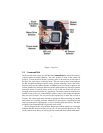3) Auto DX film speed setting 0 = on, 1 = off
4) Use of * button
0 = AF start with shutter button, exposure lock with "*" button
1 = AF start with "*" button, exposure lock with shutter button
2 = same as 0, plus DOF check with "*" button
5) Mirror lock with self timer
0 = normal ten second self timer,
1 = mirror locks up and the self timer becomes two seconds
6) Second curtain flash sync 0 = off, 1) = on
7) AF assist beam 0 = off, 1) = on
8) Spot & FEL to focus point
0 = Partial meter & Flash Exposure Lock at center point only
1 = Partial meter and FEL follow the active AF sensor
9) Force 1/125 sync in AV mode
0 = In Av mode with flash provides full ambient exposure
1 = In Av mode the shutter is locked at 1/125 second
10) AF indicator lights 0 = off, 1) = on
11) Eye control DOF preview 0 = off, 1) = on (Elan IIe only)
3 Other Camera Controls & Features
3.1 Auto Exposure Lock Button
Just behind the top mounted LCD are two thumb buttons. The one on the left is the
AE Lock button. It’s marked with a "*-cf" symbol. The "cf" part of the symbol is to
denote that it is used to set the values of the custom functions, explained above. When
the camera is not set to the CF mode on the Command Dial, the AE Lock button can
do several things. Its primary purpose is to set the exposure for one scene and then
recompose the picture. This works particularly well with partial metering where you
want to meter a subject but compose the scene with the subject off center.
Normally pressing the shutter button half way activates autofocus, and pressing the
AE Lock button locks the exposure value that is determined by the camera’s metering
system. This is called Auto Exposure Lock (AEL). However, if custom function #4 is
set to "1" the functions are reversed. The primary reason you might want this is to move
your auto focus away from the shutter button. That way you would only reactivate AF
when you wanted to, not every time you press the shutter. If you couple this with
Canon’s USM lenses that allow Full Time Manual focusing (FTM), you can autofocus
by the push of the "*" button, and manually focus by turning the focus ring on the lens,
all without switching the AF/MF switch on the lens. This may not sound like a big
deal, but for many photographers this is the primary reason to buy Canon equipment.
The low end line of Canon lenses use a micro motor USM that does not allow FTM, so
pay attention to what you’re putting your money down for. USM stands for UltraSonic
Motor. They are nearly silent and the mid and upscale ones are fast!
Nikon has recently started selling a few Silent Wave lenses that are essentially the
same thing as USM. Only some of the high-end lenses have this "S" designation and
11


















